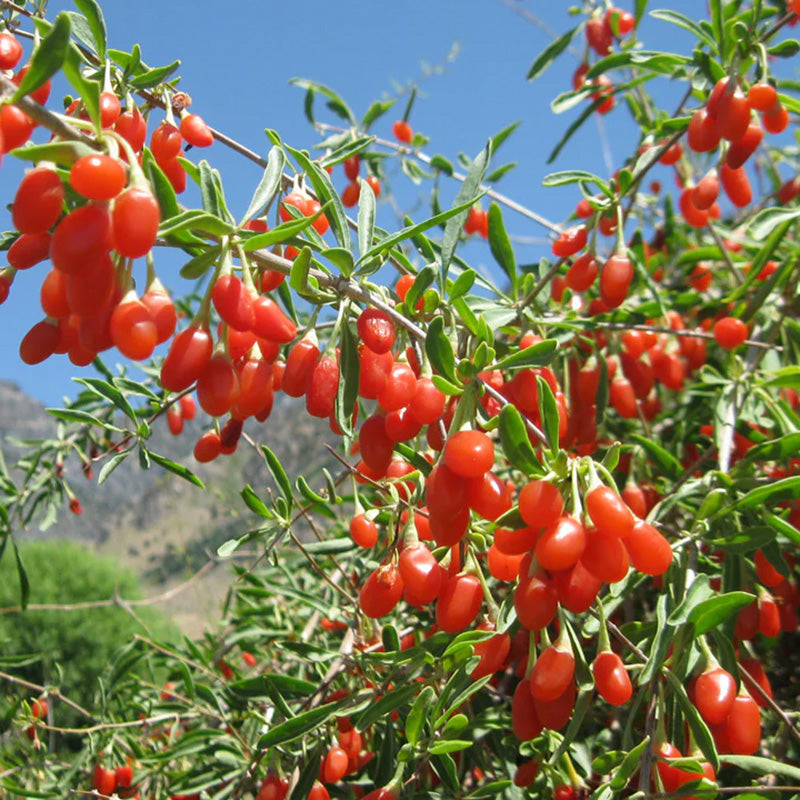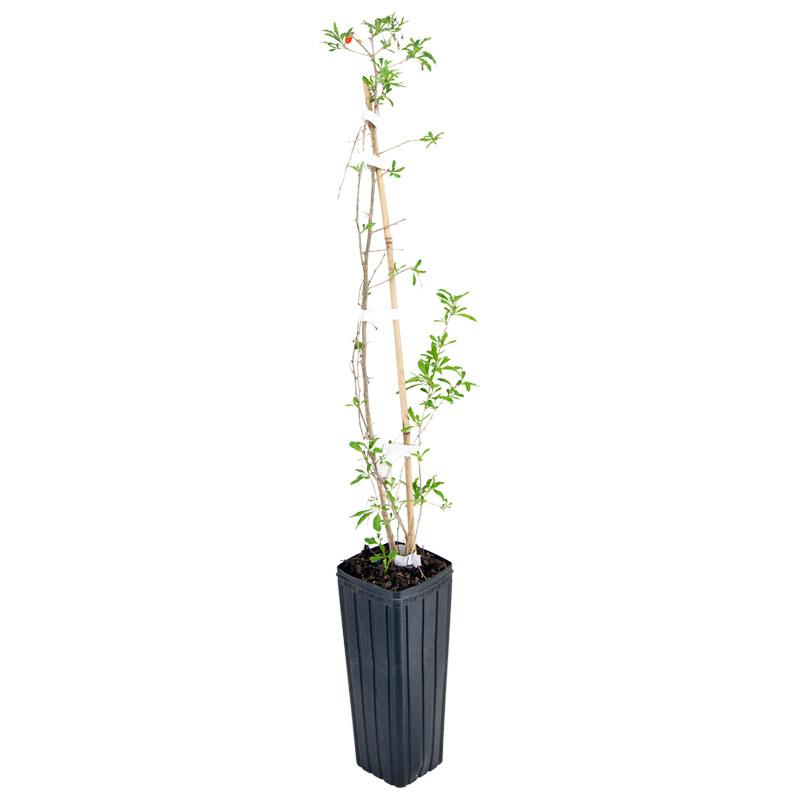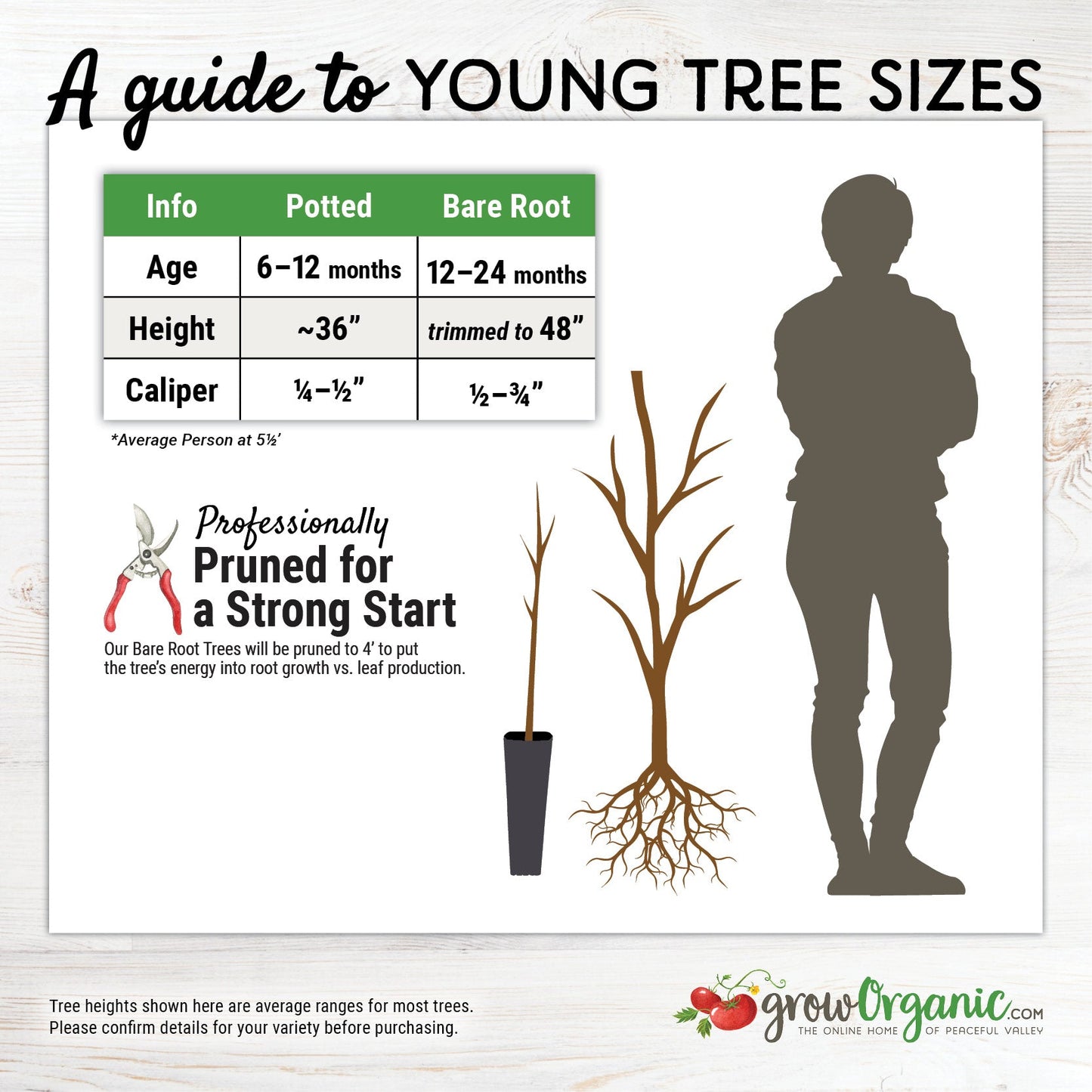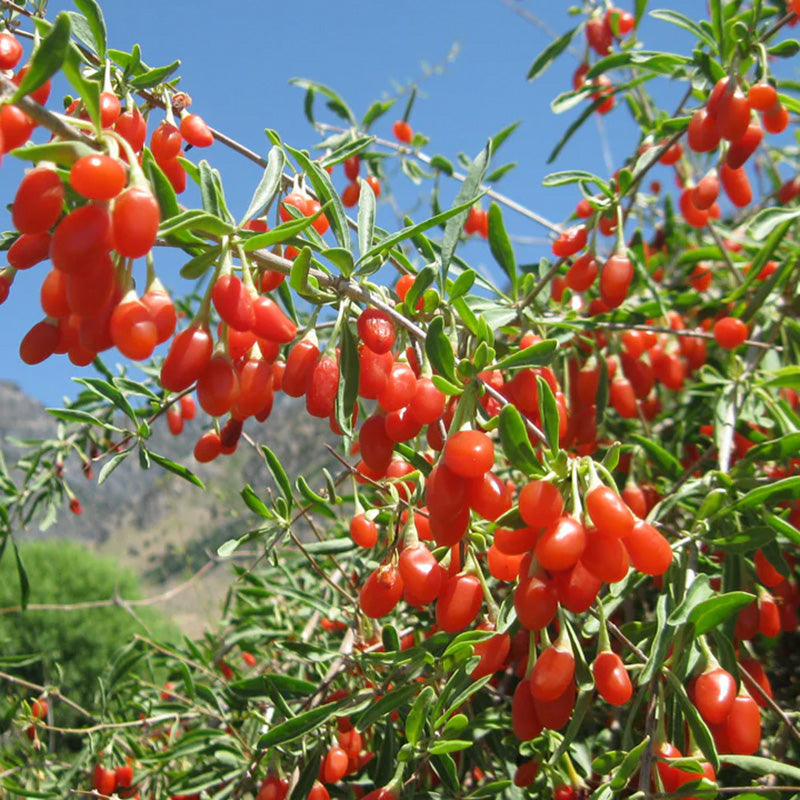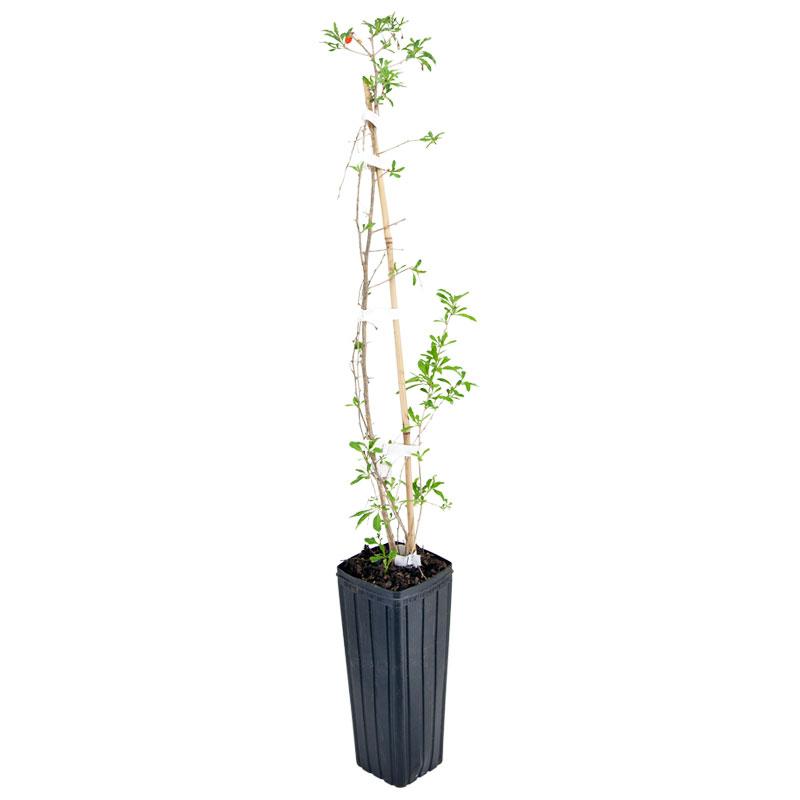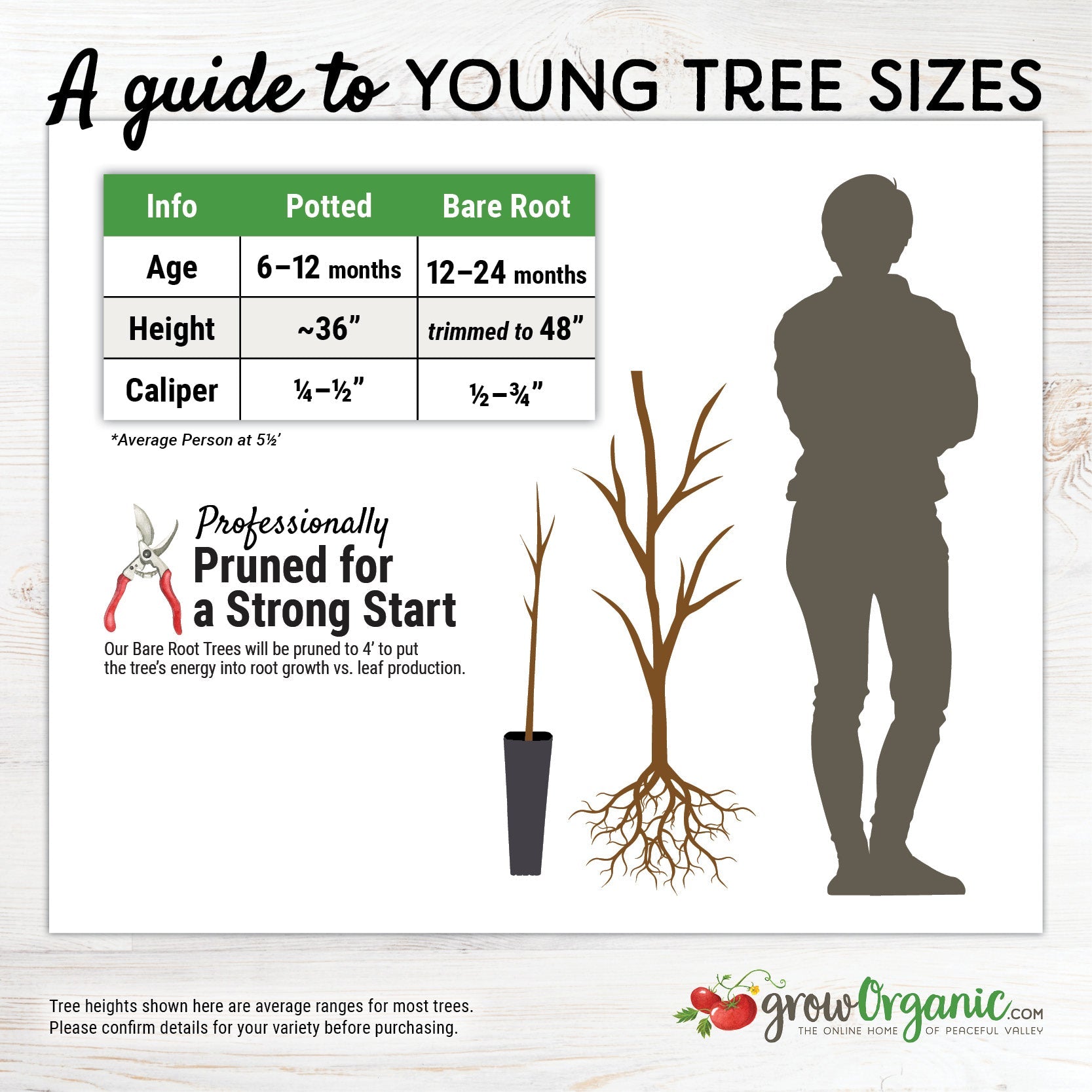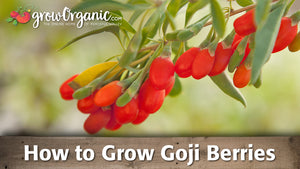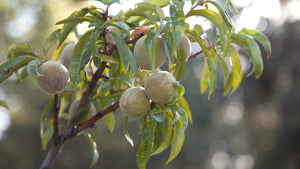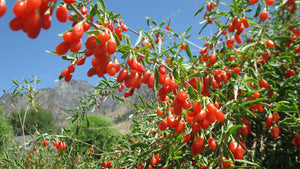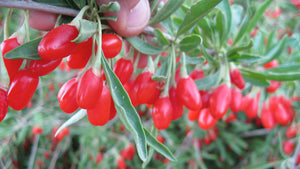Item Number: FT335
Goji Berry (Potted)
Goji Berry (Potted)
Superfood With Striking Colors
Potted Tree
- Latin Name: Lycium barbarum
- Zones: 3-10
- Harvest: Mid-Summer through first frost.
- Bush Habit: Unpruned it grows to between 10 and 13 feet tall with a spread of 4 feet. It has upright sprouts with long lateral branches with a weeping habit. Note the plant does have thorns.
- Fruit: Red to red-orange berries
- Facts of note: Goji berries are easy to grow, container adaptable and drought tolerant. They do require alkaline soil with a pH between 6.8 and 8.1. Do not apply any nitrogen and they really don't need any fertilizer.
The Goji Berry: A Nutrient-Packed Superfood
The Goji Berry, scientifically known as Lycium barbarum, has gained popularity in recent years for its numerous health benefits and unique taste. Native to China, this small, bright red berry is often referred to as the "wolfberry" and has been used for centuries in traditional Chinese medicine for its medicinal properties. In this article, we will explore the Goji Berry's origins, nutritional value, potential health benefits, and how to grow and care for this remarkable plant.
Origins and Cultivation
Goji Berries have a rich history dating back over 2,000 years in traditional Chinese medicine. They are primarily cultivated in the Ningxia region of China, where they have been an integral part of local diets for generations. These berries thrive in temperate climates with plenty of sunlight, well-drained soil, and moderate rainfall. While they originated in China, Goji Berry cultivation has spread to other parts of the world, including North America, Europe, and Asia.
Nutritional Value
Goji Berries are often touted as a superfood due to their exceptional nutritional content. These small berries are packed with essential vitamins, minerals, and antioxidants. Here are some key nutrients found in Goji Berries:
Vitamins: Goji Berries are rich in vitamins A, C, and E, which contribute to their antioxidant properties and support a healthy immune system.
Minerals: They contain essential minerals like iron, zinc, and selenium, which are important for maintaining overall health and well-being.
Amino Acids: Goji Berries provide a source of amino acids, including all eight essential amino acids, making them a valuable addition to a vegetarian or vegan diet.
Antioxidants: These berries are known for their high levels of antioxidants, particularly zeaxanthin and beta-carotene, which may help protect the eyes and reduce the risk of age-related eye diseases.
Fiber: Goji Berries are a good source of dietary fiber, which can aid in digestion and promote a feeling of fullness, helping with weight management.
Health Benefits
The consumption of Goji Berries has been associated with various health benefits, although more research is needed to confirm some of these claims*. Some potential health benefits of Goji Berries include:
Antioxidant Protection: The high antioxidant content in Goji Berries may help combat oxidative stress and reduce the risk of chronic diseases.
Eye Health: The zeaxanthin and beta-carotene in Goji Berries have been linked to improved eye health and reduced risk of age-related eye conditions like macular degeneration.
Immune System Support: Goji Berries are believed to boost the immune system due to their high vitamin C content.
Skin Health: Some studies suggest that Goji Berry extracts may promote healthy skin by reducing signs of aging and improving skin hydration.
Blood Sugar Control: Goji Berries may help regulate blood sugar levels and improve insulin sensitivity, making them potentially beneficial for individuals with diabetes.
Growing and Caring for Goji Berry Plants
If you're interested in cultivating your own Goji Berry plants, here are some essential tips:
Planting: Choose a sunny spot with well-drained soil. Space the plants about 3-5 feet apart.
Watering: Goji Berry plants prefer consistent moisture, so water them regularly, especially during dry periods.
Pruning: Prune your Goji Berry plants to maintain their shape and encourage better fruit production.
Harvesting: Berries ripen from late summer to early fall. Harvest them when they are fully red and slightly sweet.
Pests and Diseases: Keep an eye out for common pests like aphids and diseases like powdery mildew. Use organic pest control methods as needed.
The Goji Berry is a remarkable superfood with a rich history and a wide array of potential health benefits. Whether you choose to enjoy them fresh, dried, or in supplement form, incorporating Goji Berries into your diet can be a delicious and nutritious way to support your overall well-being. If you decide to grow your own Goji Berry plants, following proper care and cultivation practices can lead to a bountiful harvest of these vibrant and nutritious berries.
Visit our Fruit Tree Central for a listing of all our fruit tree videos and articles.
Visit Tree Characteristics for a listing of all our fruit & nut tree growing characteristics.
* Not medical advice; see a physician for more information.


Check Your Zone Compatibility:
Compatible with your zone.
Growing Zone for
,

Our Guarantee To You
Since 1976, we've served our customers at every stage of growing. Please contact us at any time. We are happy to support and assist you.
Description
Description
Potted Tree
- Latin Name: Lycium barbarum
- Zones: 3-10
- Harvest: Mid-Summer through first frost.
- Bush Habit: Unpruned it grows to between 10 and 13 feet tall with a spread of 4 feet. It has upright sprouts with long lateral branches with a weeping habit. Note the plant does have thorns.
- Fruit: Red to red-orange berries
- Facts of note: Goji berries are easy to grow, container adaptable and drought tolerant. They do require alkaline soil with a pH between 6.8 and 8.1. Do not apply any nitrogen and they really don't need any fertilizer.
The Goji Berry: A Nutrient-Packed Superfood
The Goji Berry, scientifically known as Lycium barbarum, has gained popularity in recent years for its numerous health benefits and unique taste. Native to China, this small, bright red berry is often referred to as the "wolfberry" and has been used for centuries in traditional Chinese medicine for its medicinal properties. In this article, we will explore the Goji Berry's origins, nutritional value, potential health benefits, and how to grow and care for this remarkable plant.
Origins and Cultivation
Goji Berries have a rich history dating back over 2,000 years in traditional Chinese medicine. They are primarily cultivated in the Ningxia region of China, where they have been an integral part of local diets for generations. These berries thrive in temperate climates with plenty of sunlight, well-drained soil, and moderate rainfall. While they originated in China, Goji Berry cultivation has spread to other parts of the world, including North America, Europe, and Asia.
Nutritional Value
Goji Berries are often touted as a superfood due to their exceptional nutritional content. These small berries are packed with essential vitamins, minerals, and antioxidants. Here are some key nutrients found in Goji Berries:
Vitamins: Goji Berries are rich in vitamins A, C, and E, which contribute to their antioxidant properties and support a healthy immune system.
Minerals: They contain essential minerals like iron, zinc, and selenium, which are important for maintaining overall health and well-being.
Amino Acids: Goji Berries provide a source of amino acids, including all eight essential amino acids, making them a valuable addition to a vegetarian or vegan diet.
Antioxidants: These berries are known for their high levels of antioxidants, particularly zeaxanthin and beta-carotene, which may help protect the eyes and reduce the risk of age-related eye diseases.
Fiber: Goji Berries are a good source of dietary fiber, which can aid in digestion and promote a feeling of fullness, helping with weight management.
Health Benefits
The consumption of Goji Berries has been associated with various health benefits, although more research is needed to confirm some of these claims*. Some potential health benefits of Goji Berries include:
Antioxidant Protection: The high antioxidant content in Goji Berries may help combat oxidative stress and reduce the risk of chronic diseases.
Eye Health: The zeaxanthin and beta-carotene in Goji Berries have been linked to improved eye health and reduced risk of age-related eye conditions like macular degeneration.
Immune System Support: Goji Berries are believed to boost the immune system due to their high vitamin C content.
Skin Health: Some studies suggest that Goji Berry extracts may promote healthy skin by reducing signs of aging and improving skin hydration.
Blood Sugar Control: Goji Berries may help regulate blood sugar levels and improve insulin sensitivity, making them potentially beneficial for individuals with diabetes.
Growing and Caring for Goji Berry Plants
If you're interested in cultivating your own Goji Berry plants, here are some essential tips:
Planting: Choose a sunny spot with well-drained soil. Space the plants about 3-5 feet apart.
Watering: Goji Berry plants prefer consistent moisture, so water them regularly, especially during dry periods.
Pruning: Prune your Goji Berry plants to maintain their shape and encourage better fruit production.
Harvesting: Berries ripen from late summer to early fall. Harvest them when they are fully red and slightly sweet.
Pests and Diseases: Keep an eye out for common pests like aphids and diseases like powdery mildew. Use organic pest control methods as needed.
The Goji Berry is a remarkable superfood with a rich history and a wide array of potential health benefits. Whether you choose to enjoy them fresh, dried, or in supplement form, incorporating Goji Berries into your diet can be a delicious and nutritious way to support your overall well-being. If you decide to grow your own Goji Berry plants, following proper care and cultivation practices can lead to a bountiful harvest of these vibrant and nutritious berries.
Visit our Fruit Tree Central for a listing of all our fruit tree videos and articles.
Visit Tree Characteristics for a listing of all our fruit & nut tree growing characteristics.
* Not medical advice; see a physician for more information.
For centuries the Chinese have used parts of the entire goji plant for food or medicine. Use of stems and leaves is little known in the United States, but the highest concentrations of healthful antioxidants can be found in the leaves. Fruit in the health food market in the form of dried berries and juice is more familiar.
For successful growth, is critical that the soil pH remain at 6.8 or higher. High nitrogen is not recommended for these plants.
Note: Plants are 1 year old and are between 18-24" tall.
Shipping Information
Shipping Information
Cannot ship to the following states: HI, AK, PR, GU, VI
Cannot ship via USPS.
Cannot ship via SmartPost.
Shipping Weight: 4.58 lb
Dimensions: 35.9"L x 3.9"W x 3.9"H
Features
Features
- Container Compatible
- Potted
- Self-fruitful
- Somewhat Drought Tolerant
- Suited to Cold Climates
- Suited to Warmer Climates
Characteristics
Characteristics
Planting & Care
Planting & Care
Useful Information
Useful Information
Guarantee
Guarantee
We guarantee the perishable items we sell to be in good, viable condition when we sell them. Perishable items include, but are not limited to, garlic bulbs, flower bulbs, seed potatoes, onion sets & transplants, potted or bare root trees, vegetable crowns, etc. If your perishable item arrives in substandard condition, take photographs and please contact us within 3 days of the purchase date (or delivery date) and we will provide you with a refund of the purchase price (excluding shipping costs), or a replacement. Accordingly, we urge you to open any boxes marked as ""Perishable"" immediately upon receiving them and inspect the shipment thoroughly (do not crack open heads of garlic, we do not accept claims on cracked garlic). Because some perishable items can deteriorate very quickly, we cannot accept any claims beyond the 3-day time frame as it becomes too difficult to determine if these items were delivered in substandard condition, or if they turned into such substandard condition because of having been improperly cared for or stored once delivered.
Share
